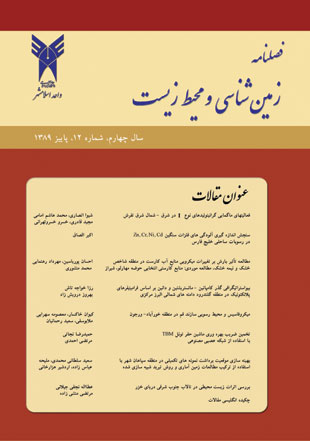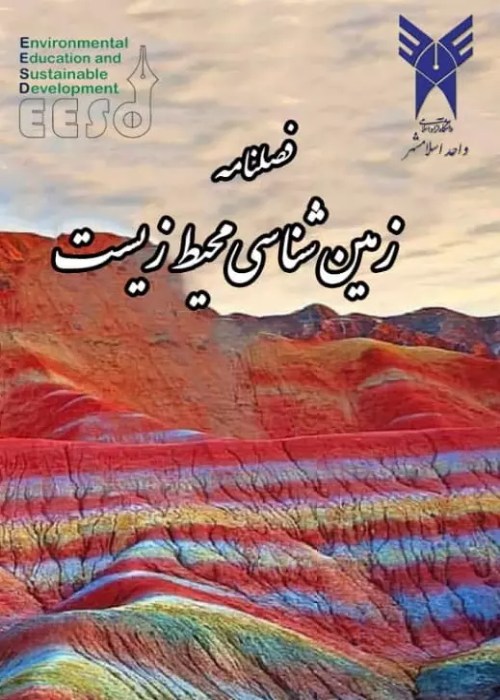فهرست مطالب

نشریه زمین شناسی محیط زیست
پیاپی 12 (پاییز 1389)
- تاریخ انتشار: 1389/09/09
- تعداد عناوین: 8
-
مطالعه تاثیر بارش بر تغییرات میکروبی منابع آب کارست در منطقه شاخص خشک و نیمه خشک / مطالعه موردی: کارستی انتخابی حوضه مه ارلو، شیراز، ایرانصفحه 27
-
Page 1The polyphase Nevis granitoid pluton extends 70 km2, is located in Urmieh-Dokhtar zone, shows variation which in terms of emplacement depth is related to epizonal to mesozonal environments [16], and in range of acidic to basic including tonalite, granodiorite, granite, monzonite, diorite and gabbro. The mentioned pluton is intruded to different units of volcano-sediments (according to the 1:250000 Geological Survey map) of Eocene sequences (E1, E2, E3, E4,E5, E6) and has imposed a contact metamorphism in Eocene 3]. Existance of mafic enclaves in the main body could confirm the initial basic-intermediate magma replacement. According to the coarse granular texture of these basic-intermediate rocks can be said that they have been replaced in crust middle depths (mesozonal) and in later stages, a large size of tonalitic magma intruded to the region shows variation in texture. Part of this tonalitic magma get to higher levels and show porphyry textures. Then they involved in mylonitic textures under tectonic stresses. Stress effects produced subgrain minerals and undulose extinction. The final phase of plutonism was made up leucocratic micro-granite and granophyres, comparing to tonalite they have limited volume and they are the most shallow plutonism in the area. Another pervasive process had been the effects of heat and fluid (hydrothermal process) caused by successive injections which had different influences on the rocks, and created secondary mineral paragenesis of greenschist facies including epidote, chlorite, calcite, albite, sphene and opaque minerals, represent the geothermal system activities in different phases and the formation history of polyphase Nevis pluton. Based on field surveys, lithology and geochemical, granitoids are I-type. These rocks are calc alkaline and metaluminous.Keywords: Nevis, petrography, geochemistry, enclave, Tafresh
-
Page 15In recent years, many industries activities such as refining crude oil, aluminum and zinc production, ship repair and construction, loading and unloading of minerals and chemicals, etc. As a development center in Bandar Abbas, southern Iran, which formed the subject exacerbate pollution load destruction of sensitive ecosystems coastal waters region. Therefore, measures to identify and measure heavy metals and trace elements with regard to harmful effects on marine ecosystems including aquatic and consequently affects puts man in sediments of coastal waters is an important. Based on this in this study the amount of heavy metals Zn, Cr, Ni and Cd in sediments in coastal areas target Bandar Abbas apparatus flame atomic absorption spectroscopy (AAS) was measured. All stages of sample and digestion of sediment according to standard methods (MOOPAM) were. Thus, the average concentration of heavy metals Zn, Cr, Ni and Cd in sediments, respectively 89.1 ± 0.3, 90.4 ± 0.3, 27.9 ± 0.3 and 2.1 ± 0.2 (μg g-1) dry weight sediment, respectively. This value with an average concentration of elements in sediments above and other global internal and external areas were analyzed and compared. Statistical analysis (ANOVA: Single Factor) showed that the average concentration of heavy metals Zn, Cr, Ni and Cd in sediment are significant differences between the crossings. Two elements Cd and Zn with a correlation coefficient of 0.7651 have the highest correlation and then the order of elements Ni and Cr with the coefficient correlation 0.7410, Cd and Cr with the coefficient correlation 0., Zn and Cr coefficient correlation 0.5603 and Ni and Zn with the coefficient correlation 0.1704 are. With coefficient significant and positive correlation between Cd and Zn, Cd and Cr, Zn and Cr and finally be determined that the source of pollution in the sediments of these elements is the same. The results show there are no statistically significant correlations for Cd, Ni coefficient.Keywords: heavy metals, Persian Gulf, Bandar Abbas, coastal sediment
-
Page 27Each karstic aquifer has its own singular hydrodynamics behavior, flow pattern and infiltration capacity characteristics. Recent studies have shown that the karst aquifers responses to infiltration events are very important. In this research, studies reveal the effectiveness of rainfall events on the index bacterial concentration in dry and wet period in a semi-arid region, Maharlu basin. But total rainfall does not have any determined relationship with total bacterial concentration in the selected karst water resources, so we need to prospect any event as unique.Keywords: Karst, Alluvium, Aquifer, Maharlu, Escherichia coli
-
Page 39In central Alborz Mountains in north of Iran, a new Cretaceous-Tertiary boundary (K/T) section near Galanderud Mine in Mazandaran province reveals diversity of planktonic foraminiferal the fauna similar to those found in ElKef & Elles in Thunisia. The Cretaceous-Tertiary boundary is located by planktionic foraminifera with in a narrow interval bounded by last appearance of tropical and subtropical Cretaceous species and first appearance of small Tertiary species. In Galanderud section only 5 species survived after the Cretaceous-Tertiary boundary event and 31 species of Cretaceous became extinct in or before Cretaceous-Tertiary boundary. The Maastrichtian species that seem to died out gradually are generally large and cosmopolitan.Keywords: Biostratigraphy, Cretaceous, Tertiary boundary (K, T), planktonic foraminiferal
-
Page 51Qom Formation in the section of Verjun-KHurabad area constitutes 852 meters of limestones in thin layers to thick layers, marl, gypsiferous marl, sandstones, and lime sandstones. Its lower contact (section a) is abrupt and mild unconformity with lower red formation. Its upper contact (section f) is gradual and concordant with upper red formation. Besides sampling, lithology changes, stratigraphy, geomorphology of stone units was examined. The results led to drawn the stratigraphy log of Qom Formation in the studied area. Petrography and microfacies studies together with field evidences led to recognition of eight carbonated microfacies in different parts of Qom Formation. This microfacies lied on the tidal, barrier, lagoon and open marine environments. The study of facies and their succession in the mentioned area and compare with modern and old sedimentary environment shows that Qom Formation was deposited in a warm marine environment. Also, the facies of Qom Formation in the studied area was deposited in a carbonated ramp environment.Keywords: Microfacies, Qom Formation, Oligo, Miocene, Carbonated Ramp, Petrography, Geomorphology
-
Page 63Determination of schedule and bid prices for mechanized tunneling needs to estimate of tunneling machine advance rate. Also determination of machine advance rate needs to estimate machine utilization. Although some empirical equations were proposed for this purpose, these equations don’t have good accuracy. The aim of this study is estimation of TBM utilization with artificial neural networks. For this purpose data set of open TBM tunneling was gathered and a neural network with 5 inputs (in-situ stress, uniaxial compressive strength, disc thrust, joint orientation factor and Q rock mass classification index) and one output (TBM utilization) was designed. Since input parameters have a good relationship with output parameter, neural network estimate TBM utilization with high accuracy.Keywords: Utilization, Neural Network, Joint Orientation, Tunneling, TBM
-
Page 73Optimization of sampling scheme is one of the important and attractive issues for geo statisticians and geochemists. So far, various methods have been presented for optimization of sampling location (initial and additional samples). In this article, it is tried to optimize the location of additionalsampling in environmental studies of Sepahan-Shahr area, by simulated annealing method. In Sepahan-shahr area, adjacency to pollutant factor (Irankooh mining area), in addition to the winds blowing whole the year from the side of this mine; have increased the pollution potentiality of the area. In this article, it is tried to optimize the location of additional sampling on the basis of the data obtained from initial samplings. For this purpose, objective function has been defined as “estimation variance minimization”, and simulated annealing optimization method has been used for solving this optimization problem. All the codes related with computation of objective function are prepared by Matlab software. Additional sampling proposed by this method will result in reduction of average estimationvariance of the area from 0.34 to 0.22, which is the highest reduction of estimated uncertainty possible to make in the results of 20 additional samples.Keywords: geostatistic, simulated annealing method, optimization, environmental sampling
-
Page 81In this work, the environmental impact assessment in a restricted lagoon at south-eastern coasts of Caspian Sea is investigated. The main source of pollution is an aquaculture plant which used the lagoon water for intake and outfall its waste water. Both numerical modeling and field investigations are used to study the effects of pollution which discharge into the lagoon by an adjacent industrial plant. The numerical model is a coupled hydrodynamic and advection-dispersion model which calibrated using field measurement. It was concluded that the accumulation of pollution in lagoon will be occurred because of the long flushing time and low-order windinduced water current.Keywords: Restricted lagoon, Water quality, Caspian Sea, Numerical modeling, Field investigations


